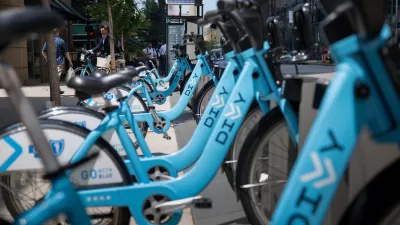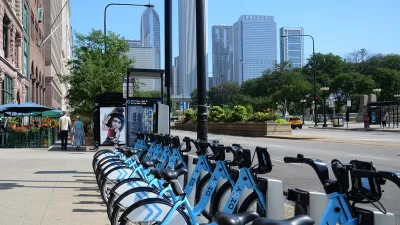Chicago is focusing its bikeshare installation in locations with what writer John Greenfield calls a "dearth of Divvy."

"While the Divvy system serves a large percentage of our city’s square mileage, as well as serving the suburbs of Evanston and Oak Park, it’s currently a lot more useful in some Chicago neighborhoods than others," according to an article by John Greenfield.
After an initial rollout that focused on high density neighborhoods near downtown, the North Lakefront, and the Near Northwest Side, Divvy began to expand its facilities to communities on the South and West side, but in more spaced out allotments. "Lower station density has been a factor in less Divvy use in these newer service areas," explains Greenfield.
The Chicago Department of Transportation is taking additional steps to remedy the gaps in the system, however. Greenfield reports that at a recent Mayor’s Bicycle Advisory Council meeting, "CDOT deputy commissioner Luann Hamilton announced that the city will be adding 40 more stations and 400 more bikes to the system." The new bikes and stations will add station density in some of the neighborhoods with a "dearth of Divvy."
"The expansion, which will grow the system to about 620 stations and 6,200 bikes, is being funded by a federal Congestion Mitigation and Air Quality Improvement grant plus Divvy revenue," adds Greenfield. More details are available in the original article.
FULL STORY: Divvy Will Add 40 More Stations This Year, Increasing Density in Underserved Areas

Planetizen Federal Action Tracker
A weekly monitor of how Trump’s orders and actions are impacting planners and planning in America.

Chicago’s Ghost Rails
Just beneath the surface of the modern city lie the remnants of its expansive early 20th-century streetcar system.

San Antonio and Austin are Fusing Into one Massive Megaregion
The region spanning the two central Texas cities is growing fast, posing challenges for local infrastructure and water supplies.

Since Zion's Shuttles Went Electric “The Smog is Gone”
Visitors to Zion National Park can enjoy the canyon via the nation’s first fully electric park shuttle system.

Trump Distributing DOT Safety Funds at 1/10 Rate of Biden
Funds for Safe Streets and other transportation safety and equity programs are being held up by administrative reviews and conflicts with the Trump administration’s priorities.

German Cities Subsidize Taxis for Women Amid Wave of Violence
Free or low-cost taxi rides can help women navigate cities more safely, but critics say the programs don't address the root causes of violence against women.
Urban Design for Planners 1: Software Tools
This six-course series explores essential urban design concepts using open source software and equips planners with the tools they need to participate fully in the urban design process.
Planning for Universal Design
Learn the tools for implementing Universal Design in planning regulations.
planning NEXT
Appalachian Highlands Housing Partners
Mpact (founded as Rail~Volution)
City of Camden Redevelopment Agency
City of Astoria
City of Portland
City of Laramie




























